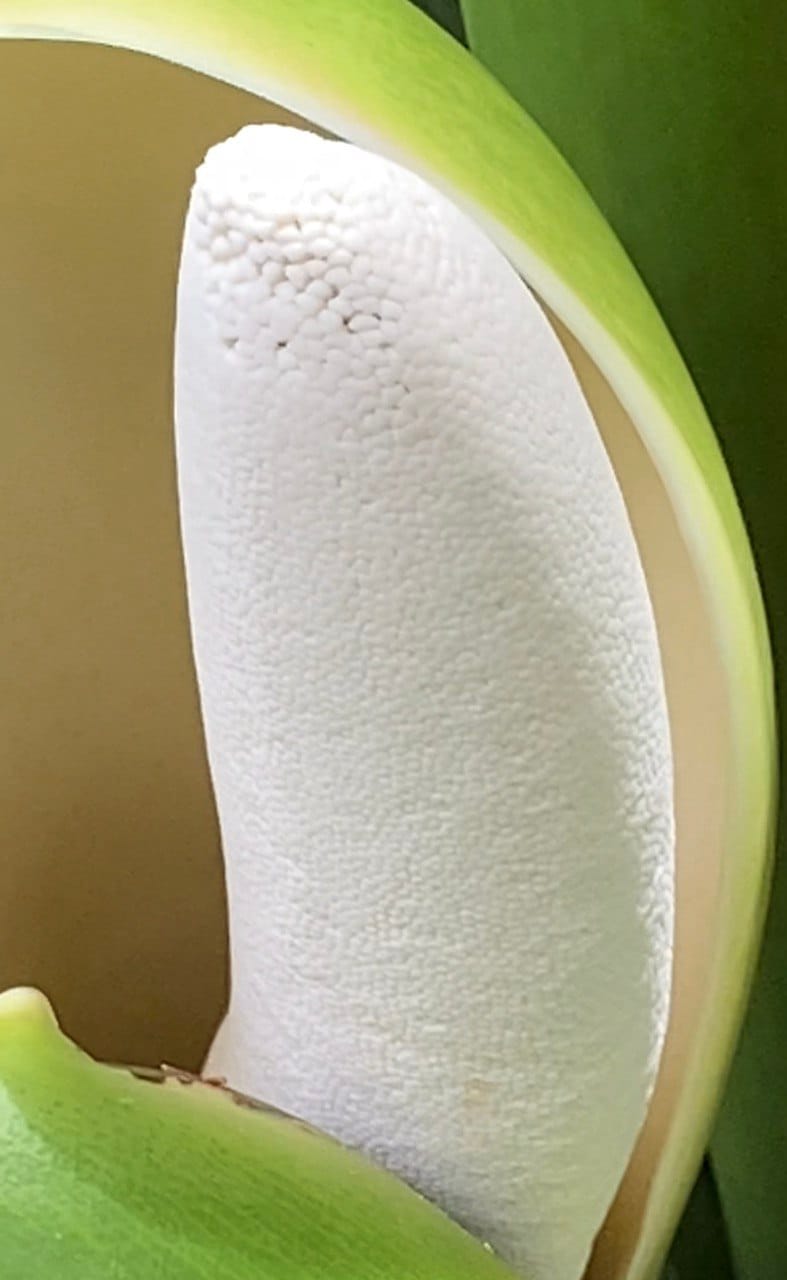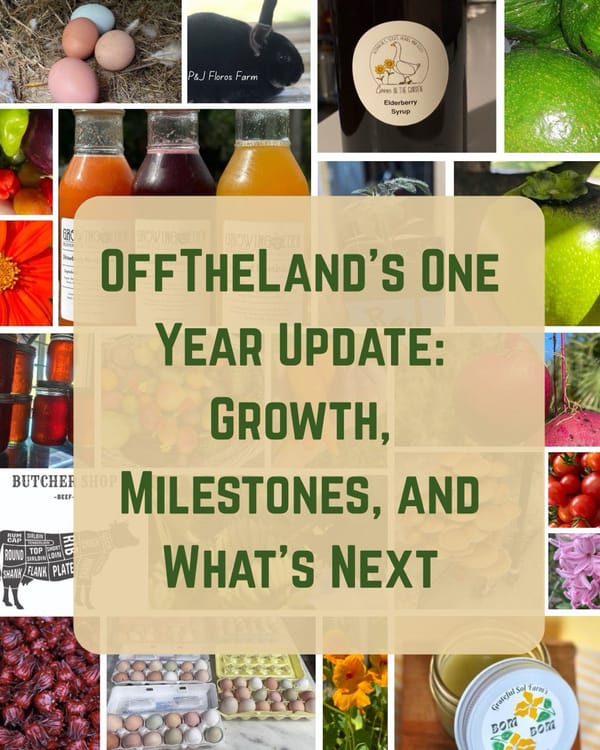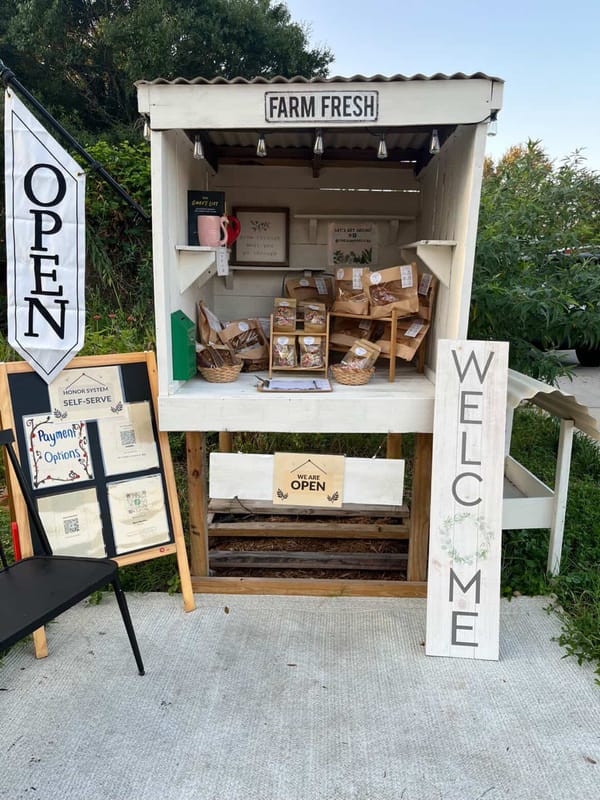🌿 Your Lifetime Leafy Friend: The Complete Guide to Split Leaf Philodendron Selloum (Thaumatophyllum bipinnatifidum)
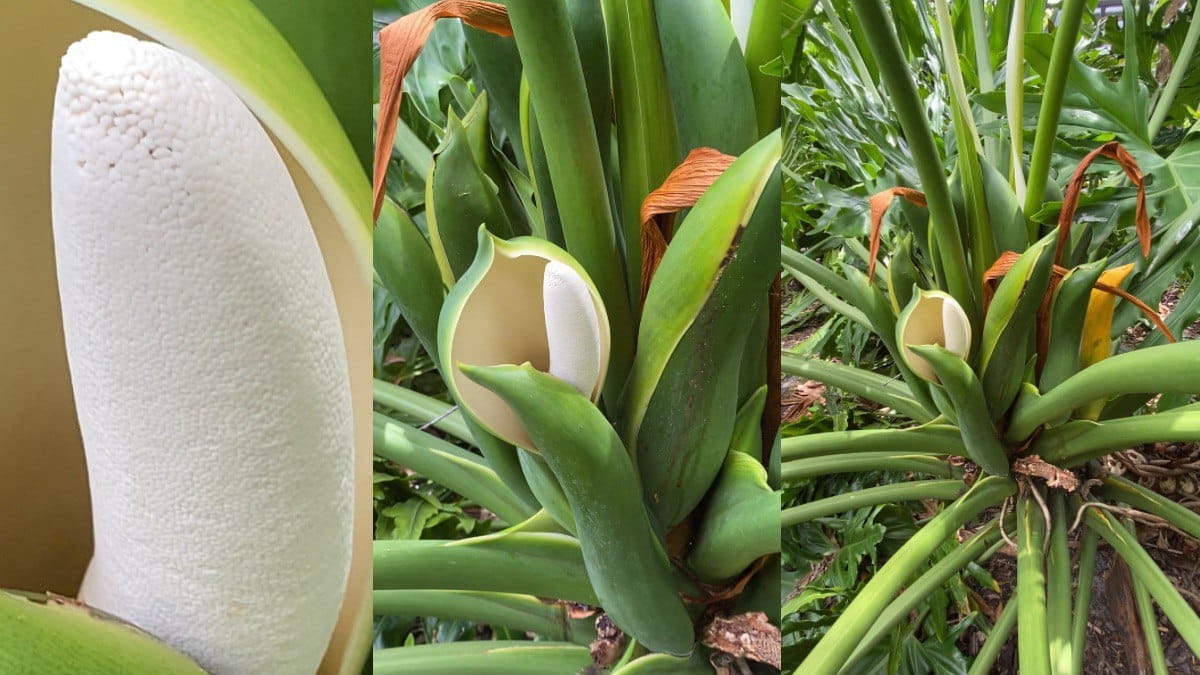
Everything you’ll ever need to know about this leafy giant
Disclaimer (for best vibes): Before diving in, hit play on Just Me & My Plants or Propagatin by Rocco Elliot. Because honestly, reading about houseplants should come with a soundtrack.
📖 Table of Contents
- 🌱 Introduction: The Plant with Many Names
- 🌿 The Identity Crisis: Monstera vs Philodendron vs Thaumatophyllum
- 🏡 Indoor vs Outdoor Life
- 🌸 The White Thing: When Your Selloum Decides to Flower
- 💧 Care Guide (Plant Parent Hacks)
- 🐾 Safety: Pets, People & Air Purification
- 🌴 The Trunking Phase: Watching It Mature
- 🌱 Propagation & Sharing
- 🚑 Common Problems & Fixes
- 🌟 Conclusion
🌱 Introduction: The Plant with Many Names
If you’ve ever walked into a nursery or big-box store and seen a plant labeled “Split Leaf Philodendron”, chances are… it wasn’t one. Or maybe it was. Or maybe it was three different plants altogether.
Confusing? Absolutely. But here’s the good news: no matter which one you ended up with, you’ve scored yourself a showstopper. With leaves the size of your torso and a lifespan that can stretch half a century, this is the kind of plant that becomes part of the family. (Yes, you can put it in your will.)
When Your Split Leaf Philodendron Gets Fancy (Yes, They Really Flower!)
🌿 The Identity Crisis: Monstera vs Philodendron vs Thaumatophyllum
Let’s settle the name drama once and for all:
-
Monstera deliciosa
- Aka the “Swiss Cheese Plant.”
- Famous for holey, fenestrated (window-like holes) leaves.
- Outdoor growers know its fruit can be edible (when very ripe — underripe = ouch, toxic).
- Climbs with aerial roots.
-
Thaumatophyllum bipinnatifidum (formerly Philodendron Selloum, aka “Tree Philodendron”) (Can we just call it Bip?)
- The real “Split Leaf Philodendron.”
- Huge, deeply split leaves. No holes, just dramatic edges.
- Doesn’t climb — grows into a self-supporting, trunk-like base over decades.
-
Philodendron Xanadu (aka Thaumatophyllum xanadu)
- Compact cousin. Bushier growth, landscape favorite.
- Still dramatic, but more “small jungle” than “entire rainforest.”
👉 Quick ID hack:
- Holes = Monstera.
- Giant ruffles, no holes = Selloum.
- Small, bushy splits = Xanadu.
🏡 Indoor vs Outdoor Life
-
Indoors:
- Perfect as a statement plant in your living room.
- Can live happily for decades without ever outgrowing a pot (though it will eventually want more legroom).
- Fun fact: plenty of plant parents inherit 30–40 year old Selloums from grandparents.
-
Outdoors:
- Thrives in zones 9–12 (Florida, Texas, SoCal, Hawaii).
- Can become a tree-like giant, up to 10 feet tall and wide.
- Loves humidity and warmth but sulks in frost.
-
In-between zones (6–8):
- Summer vacation outdoors, winter indoors.
- Basically, a snowbird plant.
⏳ With good care? Expect 50+ years of leafy companionship.
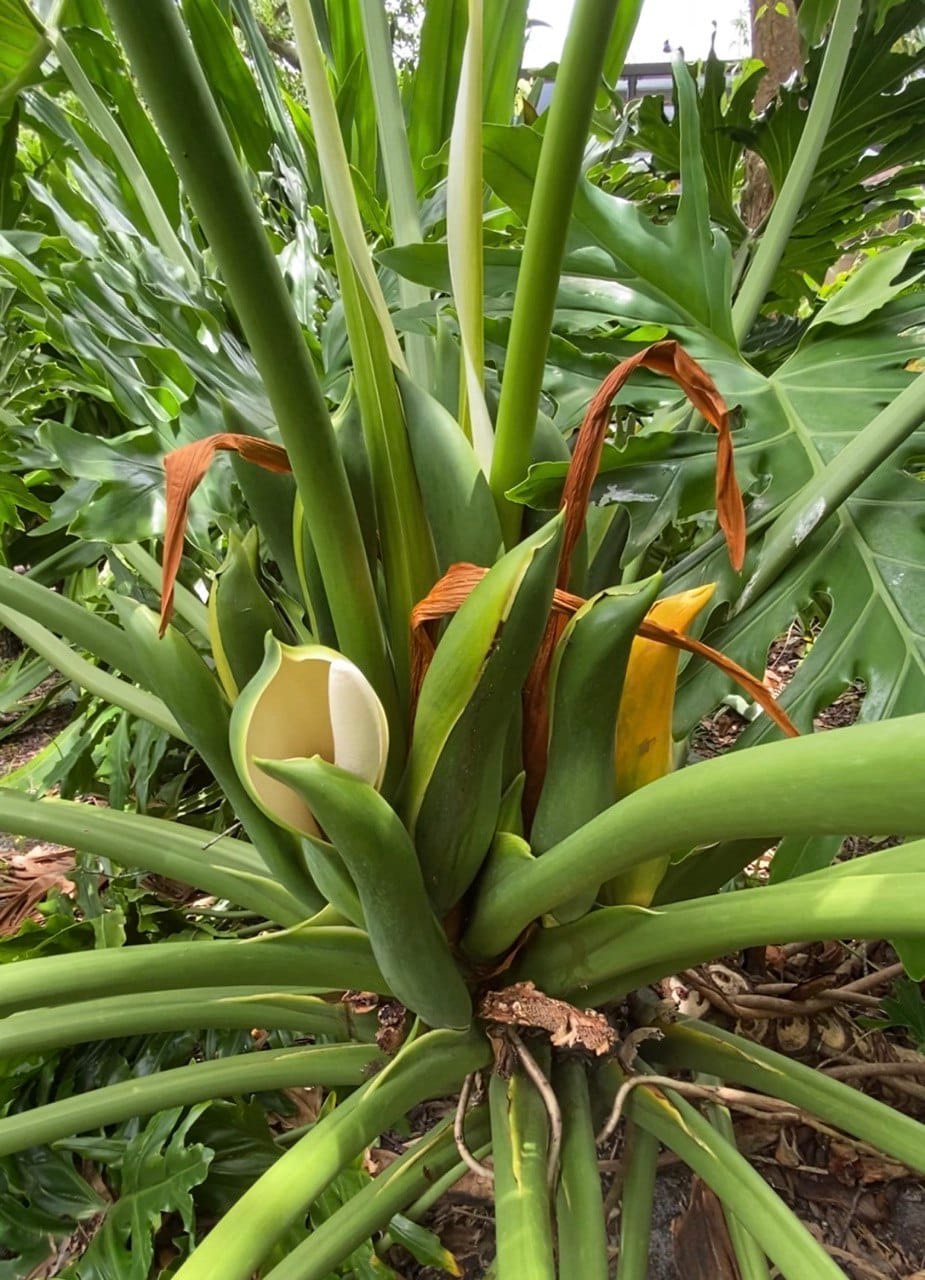
🌸 The White Thing: When Your Selloum Decides to Flower
Okay, let’s talk about the mysterious white thing your Split Leaf Philodendron might surprise you with.
What It’s Called
- Inflorescence: a plant’s flowering structure.
- In the case of Selloum, it’s made up of:
- Spadix: a smooth, white, cylindrical spike covered in teeny-tiny flowers. It tapers to a rounded tip, with a bumpy surface that looks like dots or pores.
- Spathe: a large, green, leaf-like bract that curls open like a hood to partially wrap around the spadix. Think of it as a dramatic cape.
Together, they look like an elegant tropical sculpture that’s part flower, part alien spaceship.
When & Why It Appears
- Age matters: Only mature plants (usually many years old) produce inflorescences. Your small houseplant probably won’t, but outdoor giants in warm climates often do.
- Conditions: High humidity, steady warmth, and strong light all help. Indoor environments rarely mimic the tropical cues needed to trigger flowering.
- Chemicals: No fertilizer trick will force it: it’s more about patience and maturity.
The Flower’s Secret Life
Here’s the cool part: the spadix isn’t just a spike, it’s a party zone for pollinators.
- On the first night, the female flowers (at the bottom of the spadix) open.
- The next day, the male flowers (higher up) release pollen.
- The plant even produces heat (yes, the spadix literally warms up!) and a fragrance to attract special beetles in its native habitat.
- Once pollination is done, the spathe slowly closes again, protecting the developing seeds.
What to Expect Indoors vs Outdoors
- Indoors: You’ll almost never see this spectacle. That’s why it feels like magic if it happens.
- Outdoors in Florida & similar climates: Mature Selloums can flower reliably each year.
📸 Tip: If yours ever blooms, take a photo. Your plant-parent friends will lose their minds.
💧 Care Guide (Plant Parent Hacks)
☀️ Light
- Bright, indirect light is the sweet spot.
- Outdoors, give it part shade. Direct hot sun = crispy leaves.
🪴 Soil
- Loves a chunky, airy mix. Think:
- 1 part potting soil
- 1 part orchid bark
- 1 part perlite
- Translation: “airy jungle floor vibes.”
💦 Watering
- Soak thoroughly, let the top 2–3 inches dry out before watering again.
- Pro tip: These plants hate sitting in soggy bottoms (don’t we all?).
🌱 Fertilizer
- Monthly, balanced liquid feed in spring + summer.
- Winter → let it nap.
- Epsom salt trick: 1 tsp in water once in a while = magnesium boost (great for yellowing leaves).
🪴 Repotting
- Every 2–3 years or when roots circle the pot.
- They love room to stretch.
💨 Humidity
- Will survive in average home humidity, but thrives in higher levels.
- Bonus: misting = plant spa day.
🌴 Structure
- Unlike Monstera, no moss pole required — it grows its own self-supporting trunk with age.
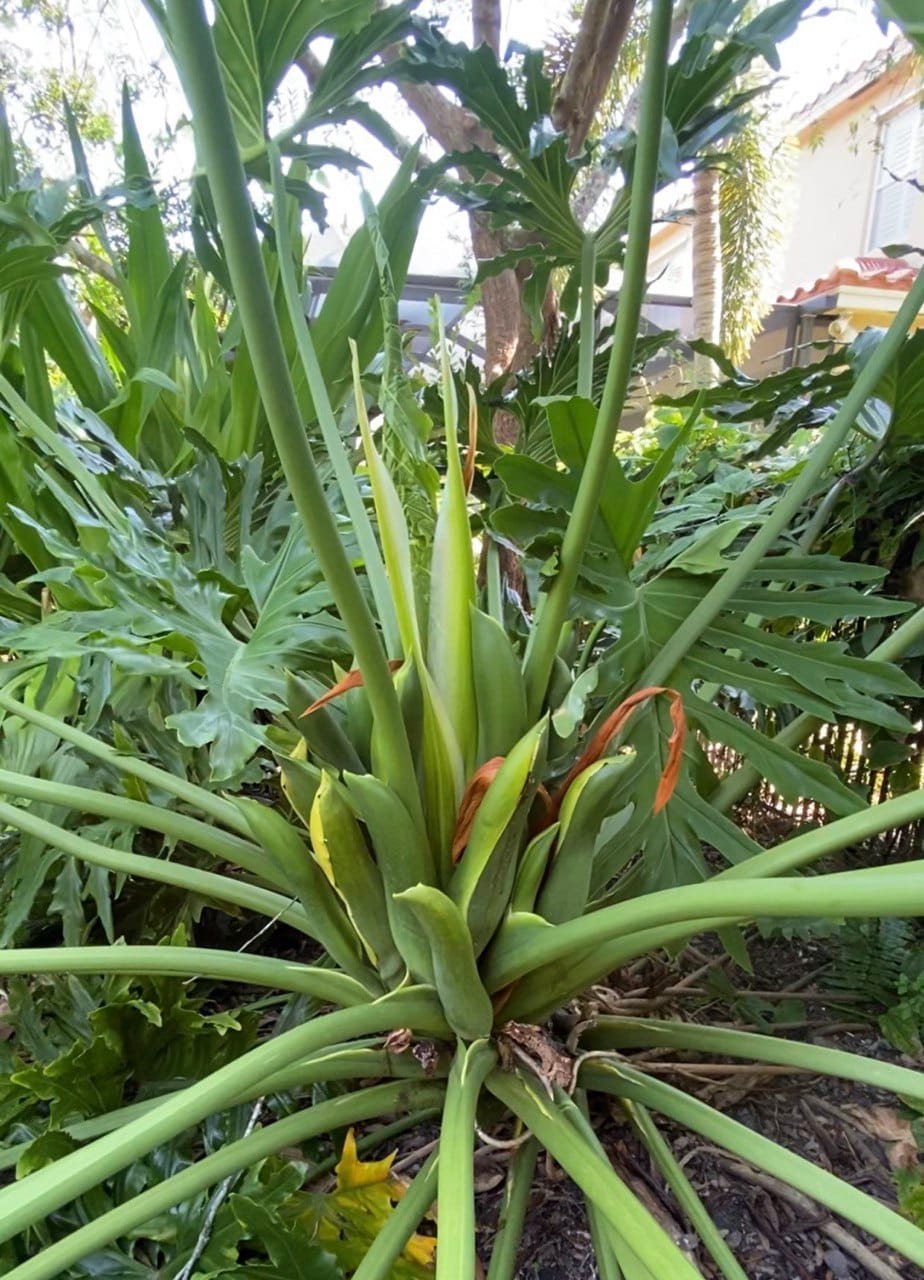
🐾 Safety: Pets, People & Air Purification
⚠️ Toxicity
-
For humans:
- The Split Leaf Philodendron contains calcium oxalate crystals, which can cause irritation if chewed or ingested.
- Don’t snack on it — save the edible plant adventures for Monstera deliciosa fruit (ripe only!).
-
For pets (cats, dogs, birds):
- Toxic if eaten. Symptoms can include drooling, pawing at the mouth, vomiting, and lack of appetite.
- Best practice → keep out of reach of curious pets.
🌬️ Air Purification
- Fun fact: The NASA Clean Air Study once listed philodendrons among air-purifying plants.
- Reality check: You’d need a jungle indoors to actually clean your air this way.
- Still, having big leafy friends around boosts humidity and mood.
🌴 The Trunking Phase: Watching It Mature
One of the most thrilling parts of raising a Selloum is watching it “trunk.”
- Young plants: Bushy leaves, no trunk yet.
- Mature plants: Over years, the base becomes woody and tree-like. Outdoors, they can form several feet of trunk. Indoors, it’s slower — but just as exciting when it happens.
- Aerial roots: These thick, snaky roots will grow from the trunk. You can let them dangle or bury them in soil when repotting.
- Staking? Nope. Unlike Monsteras, Selloums don’t need moss poles. They’re self-supporting, though you can add light support if leaves flop dramatically.
🌱 Propagation & Sharing
Yes, you can multiply your leafy friend:
- Stem cuttings:
- Snip a piece 4–6 inches long with at least one node.
- Root in water or directly in moist soil.
- Air layering:
- Wrap a damp moss ball around a node while still attached, wait for roots to form, then cut and pot.
- Passing it on:
- Many plant parents share Selloum cuttings with friends, family, or local plant swaps.
- With patience, it’s a gift that literally grows.
🚑 Common Problems & Fixes
-
Yellowing leaves:
- Normal aging (older leaves drop).
- Overwatering → adjust watering rhythm.
- Nutrient deficiency → feed monthly; magnesium boost with epsom salts.
-
Drooping or flopping stems:
- Totally normal for large leaves.
- Add a decorative support if needed.
-
Rootbound from store purchase:
- If you see roots poking out of the pot, repot soon.
-
Pests:
- Indoors → spider mites, mealybugs, scale.
- Outdoors → aphids, thrips.
- Hack: hose down + wipe leaves with insecticidal soap.
-
Diseases:
- Root rot (from soggy soil).
- Fungal leaf spot (usually from poor airflow).
- Prevention: drainage + spacing = happy plant.
🌟 Conclusion
Whether you call it Philodendron Selloum, Tree Philodendron, or Thaumatophyllum bipinnatifidum, one thing’s for sure: this leafy friend will be with you for decades.
It might confuse you with its identity, drop a yellow leaf or two, or surprise you by “trunking” like a little tree. But with patience and love, it’ll reward you with a tropical vibe so bold your living room might as well charge admission.
🌱 Want to see what your local plant community is up to? Discover plants your neighbors are giving away, sharing, trading, or selling right now on OffTheLand.net — your neighborhood’s own jungle hub.
